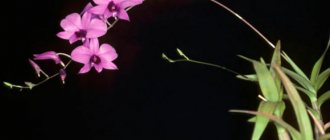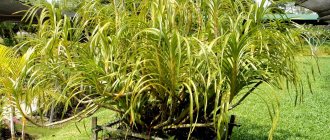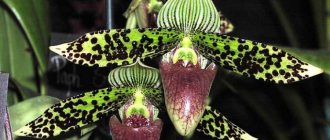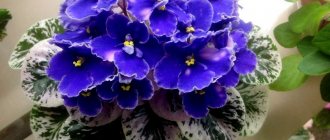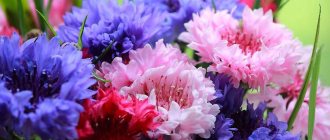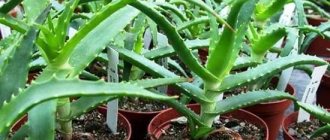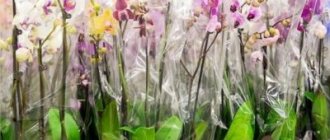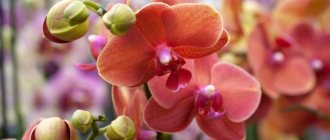Description
The classification of the family is basically based on the formation of the fused stamen and pistil (the so-called column), and the nature of the location of the anther and the upper part of the anther - the stigma.
Most orchid species grow in the tropical zone - and here they receive ideal conditions for development. And a characteristic feature of the distribution of orchids is precisely the diversity and originality of the flora of this family on different continents.
Of course, in temperate latitudes, orchids are less represented than in the tropics. For example, in temperate latitudes only 75 genera and 900 species are represented - only 10% of the total. In the southern temperate climate there are even fewer such plants. Only 419 species from the orchid family grow on the territory of our country.
Orchids in the temperate zone are represented by perennial terrestrial herbs that have underground (which is important for this family) rhizomes (tubers), but the tropics delight with epiphytic orchids.
Orchid varieties, names, descriptions and photos
There are an endless variety of varieties and varieties of orchids, among which are the following:
- Cattleya labiata
One of the largest representatives of cultivated orchids, although small cattleyas are also found. This variety has a very beautiful flower with petals covered with a waxy coating and a corrugated “lip”. The colors of the orchid flower, which “lives” for almost three weeks, are the most multifaceted - from soft pink and beige tones to deep purple.
- Orchid Cymbidium
An excellent variety of orchids, resistant to stress and easy to care for. Hanging peduncles contain 10-13 orchid flowers of the most unimaginable palette - from boiling white to purple or bright orange. This variety of orchid blooms profusely and continuously for 8-10 weeks.
- Fragrant lycaste "Golden" (Lycaste aromatica)
This variety of orchid is loved by connoisseurs for its spectacular bright lemon-colored flowers with a delicate and persistent aroma. Peduncles are tall, up to 25 cm, flowers in diameter often exceed 15-17 cm.
- Darwinara Orchid
A miniature orchid hybrid with very dark, leathery leaves and an elegant inflorescence, which includes small, 2-3 cm in diameter, blue-violet flowers. The inflorescence is racemose and may contain 7-12 flowers with a delicate aroma.
- Potinara " Burana Beauty " ( Potinara Burana Beauty, Rhyncattleanthe)
The hybrid is distinguished by luxurious variegated yellow-red flowers with wavy petals. The peduncle of the orchid is of medium height; this variety of orchid blooms all summer, and with proper care it pleases with its beauty even in the first autumn month.
- Cymbidium Twelve _ _ _
An orchid with long, rather narrow leaves. The bud of the Cymbidium “Twelve” orchid is whitish-pink in color, with a slight reddish speck. Inflorescences drooping, racemose, short.
- Orchid Dendrobium nobile
D
sometimes reaches 60 centimeters in height, the minimum height of this individual is about 30 centimeters. The diameter of one flower varies from 4 to 7 centimeters. And the branch of the Dendrobium Nobile orchid can have inflorescences of different tones.
Structure
The orchid family has a significant difference from all the usual flowering plants: we are talking about the fusion of filaments of stamens (there can be several of them - from one to three) with a style of gynicea. This fusion is called gynostemium or column - and, in addition to orchids, such a device is found only in Rafflesiaceae.
The orchid flowers themselves are usually collected in racemes or spikelets, much less often they are located alone (for example, lady’s slipper). Usually the flowers are three-membered, decorated with identical sepals. Of the three petals, the upper one forms the so-called lip - a kind of long outgrowth back, with nectar. And, since the downward position with this very lip is optimal for pollination, most orchids are faced with the process of resupination, or twisting.
Etymological meaning of the flower
Orchids get their name from the Greek word Orchis, which means testicle. This is because their fleshy tubers resemble testicles. At least, that’s what it seemed to the Greek botanist Theophrastus.
We recommend reading: Features of watering Orchids
Phalaenopsis is commonly called the Butterfly Orchid . This name was given by Swedish naturalist Per Osbeck in the mid-1750s. He confused these flowers with a cluster of moths. And although the official name for this species was given only 75 years later, the name Butterfly Orchid stuck.
Characteristics and Features
Among orchids, perennial herbs occupy a large distribution and dominant positions, although sometimes shrubs and even large vines are found among them.
Typically, in greenhouse conditions, tropical species of this family live to a serious age - about 70 years.
Along with autotrophic forms, saprophytes are also found in orchids. And according to the nature of the substrate, it is customary to distinguish between epiphytes - the largest group, as well as lithophytes and terrestrials, distributed mainly in temperate latitudes. Epiphytic orchids usually develop large aerial root systems that have no hairs but are characterized by a special absorptive tissue called velamen. Moreover, in some of them, the roots take over the function of photosynthesis instead of leaves.
How to care for an orchid?
- The orchid feels comfortable during the day at temperatures from +22 to +30°C, and at night the air temperature should not be lower than +16°C. Drafts and heat will be dangerous for this plant. A colder temperature will promote flowering, and a hotter temperature will promote the appearance of babies on the peduncle.
- Orchids like bright light. If there is no sun, then artificial light can be created using fluorescent lamps. Under no circumstances should you place your orchid in direct sunlight, as there is a risk of getting burns.
- This plant needs not only proper care at home, but also rational watering: in summer - once every 4 days, in winter - once every 7 days. It is worth remembering that overwatering will be worse than underwatering, and in doubtful cases it is better to skip watering.
- Orchids are fertilized differently during and without flowering. For flowering orchids, it is advisable to use fertilizers with a high level of phosphorus. This flower needs to be fertilized every 2-3 waterings.
- Spraying will help increase humidity. But it is worth remembering that excessive humidity at low temperatures in winter, as well as on summer nights, is dangerous because it causes spots to appear on the leaves and pseudobulbs. For the same reason, spraying orchids should be carried out at the beginning of the day so that the flower dries out by evening.
Read also: White water lily, Red Book, brief description, reproduction, application, medicinal properties
How to replant an orchid?
Under no circumstances should you replant an orchid in ordinary soil. These plants grow in pine bark substrate.
It is better to replant a flower when the plant has grown greatly or the substrate has completely decomposed. Adult epiphytic orchids are replanted every 2-3 years.
Ground orchids that lose roots during dormancy require annual replanting. The main thing is to not forget at the time of such a transplant that the roots of an orchid are more fragile than those of most other plants.
Before replanting the plant, it is worth thoroughly moistening the soil. This will make it easier to separate the roots from the walls of the pot.
Orchid diseases
Orchid diseases are a rare phenomenon and require specialist intervention:
- Bacterial leaf spot
The disease is quite easy to treat. Isolate the “sick” from other indoor plants! Remove damaged parts of the orchid by cutting them off with scissors. Treat the sections with regular green paint, cinnamon powder or activated carbon.
- Anthracnose
In case of this disease, be sure to eliminate all diseased parts on the plant! Spray the orchid with fungicides such as Sandofan, Previkur or Profit.
- Powdery mildew
If there are visible signs of this disease, generously spill the container in which the orchid is growing with water several times. After a couple of hours, spray the plant with a solution of colloidal sulfur or Topsin-M.
- Rust
The disease is serious, but treatable. The orchid plant should be thoroughly washed under running water, without fear of flooding it, and replace the substrate in the container. Then you need to spray the orchid with a faint pink solution of potassium permanganate and treat it with Manual Orchid from a spray bottle.
- Root, black, gray, fusarium rot
The affected areas on the plant must be removed by cutting them off with scissors and sprinkled with crushed activated carbon. Replace the substrate with a new one, first washing the container and the roots of the orchid in a pink solution of potassium permanganate.
- Sooty mushrooms
The flower disease can be cured by pouring the substrate twice and spraying the plant with preparations such as Mikosan or Topsin-M.
Below are answers to the most frequently asked questions among lovers of this plant.
Brief information about the flower
It is rare nowadays to meet a person who has never heard anything about orchids. Indoor plants differ significantly from their wild counterparts. Household orchids are presented in the form of flowerpots with thin stems, on the top of which are placed luxurious and outlandish flowers. Thanks to this, orchids have become incredibly popular among gardeners.
But caring for indoor orchids must meet the requirements, and it is also necessary to understand the conditions of their growth in natural conditions. Particular attention should be paid to selecting the appropriate substrate, container for planting, fertilizer, organizing proper watering, lighting, temperature and humidity. And also adhere to the recommended procedure for transplantation and reproduction. In the same way, you should not lose sight of what type of orchid you are going to grow, since each of them has its own characteristics.
Species suitable for home cultivation
Brassia
This flower looks very original thanks to its thread-like petals and sepals. The inflorescences are delicate and exquisite. The flower size is up to 10 cm. Pale green, pretty flowers have a sweetish smell. These spectacular beauties bloom in the spring.
Dendrobium
Experts have now studied many types of these orchids. They differ in color, flower shape, and have different sizes, but all of them can bloom at any time of the year. For this, some need to create conditions under which the thermometer is at +10 °C, others require a temperature of +16 °C.
These plants are classified as evergreen, but there are times when they “go bare” immediately after the first flowering.
Phalaenopsis
The peculiarity of the plant is its long stem, which has four large oblong leaf plates of dark green color, arranged in two rows. The name translated means moths. In fact, the plant resembles beautiful velvety butterflies. There are two types of phalaenopsis:
- simple (up to 1 m long);
- miniature (very small - up to 30 cm).
The plant has a perpendicular stem, the leaf blades are leathery and shiny. Those species that branch heavily have many leaves. If the plant grows in comfortable conditions, the flowers appear on thin stems for up to 4 months (depending on the type of orchid) and bloom 2-3 times a year.
Delightful flowers are compared to fluttering butterflies, dancing people, and a small charming hummingbird. Some types of phalaenopsis have a distinct, pleasant odor.
Vanda Orchid
This orchid is considered one of the most beautiful in the family. She is very popular. All this thanks to the long flowers with unique colors. Today, experts count about 53 varieties of this species, not counting the many hybrid forms.
Wanda simply fascinates with her mystery and mystery. This beauty with a chic appearance will decorate any interior with her presence. However, to enjoy its delights, you will have to work hard.
Oncidium
Plants will give everyone a head start with their effectiveness. They very much resemble air butterflies in their appearance. To observe these beautiful flowers and enjoy their appearance, you need to create comfortable conditions. First of all, this concerns the humidity of the room. They will repay you with gratitude if you assign them a place of residence in a shaded place. The magnificent flowers resemble cinquefoil and range in color from dark burgundy to light green.
Cattleya
The flower attracts the attention of others, captivating with its transparent flowers, as if covered with a waxy coating, and wavy lips. Of all domestic species, they are the largest. This type has a variety of colors and varieties. The most suitable for breeding at home are hybrid forms. They bloom magnificently for 3 months from spring to autumn.
Lelia
This orchid is very similar to Cattleya. A layman is unlikely to recognize her. In stores, indoor lilies are presented with specimens that are capable of producing one flower. Orchids have 23 varieties and come in a wide range of colors. Added to all the benefits is a spicy aroma, which becomes more intense in the evening.
Rhynhostilis
The amazingly beautiful orchid looks unusual in comparison with its “relatives”. Its small flowers are collected in inflorescences and resemble lilac clusters. The plant has an excellent aroma. The flowers form hanging “tassels” of pale pink or noble white. They are either plain or with pronounced spotting.
Aganisia
This genus cannot be called numerous. It includes only 4 species. The plant is low-growing and has a creeping stem. You can grow two types of this flower at home: blue aganisia and beautiful aganisia. The first has small flowers the color of the sky, and the second has small butterfly-sized flowers of creamy cream color. The peduncle contains from two to five of these delightful flowers.
Ludisia
The flower grows in the tropical forests of Malaysia, Sumatra. All the beauty of this indoor plant is not in the flowers, as we are used to, but in the leaves. They look unusual. Everything is amazing: the color and the shape. The leaf blades are olive and purple in color with cream veins and have a velvety surface that shimmers beautifully in the sun, emitting a glow. The plant has a small height and seems to spread, covering the surface with its luxurious leaves.
Zygopetalum
This type of orchid has short stems that become slightly thicker towards the base. They have folded, elongated leaves. The flower is notable not only for its spectacular shape, but also for its creative, unusual colors.
Some are afraid to purchase this exotic beauty, thinking that caring for her will be too difficult. But these are completely unnecessary fears, since caring for a flower is not difficult, but it is still necessary to pay attention.
By following basic rules of care, you can enjoy the incredibly beautiful flowering of this plant and its pleasant, persistent aroma, reminiscent of the smell of narcissus.
Epidendrum
This genus is the most numerous, as it includes more than 1,100 species. All of them have short ground creeping shoots, called rhizomes, and thick, hard leaves, which can be located in the upper part in pairs or alternately on erect stems. They have a distinct lanceolate shape with a pointed tip.
Some species have wide-brimmed, concave-shaped leaves. The peduncles located at the top have dense inflorescences in the form of a ball or brush. Richly colored flowers can be either large or not very large. It all depends on the species.
For centuries, orchid flowers have been admired and worshiped. They were even used to prepare love potions. The orchid still serves as a symbol of luxury and elegance today.
Orchid family (Orchidaceae)
Life of plants: in 6 volumes. — M.: Enlightenment. Edited by A. L. Takhtadzhyan, editor-in-chief, corresponding member. USSR Academy of Sciences, prof. A.A. Fedorov. 1974.
